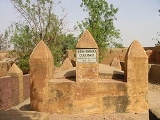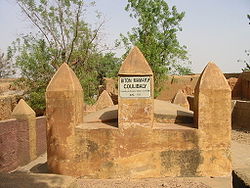
Bambara Empire
Encyclopedia

West African
West Africa
West Africa or Western Africa is the westernmost region of the African continent. Geopolitically, the UN definition of Western Africa includes the following 16 countries and an area of approximately 5 million square km:-Flags of West Africa:...
state based at Ségou
Ségou
Ségou is a city in south-central Mali, lying northeast of Bamako on the River Niger, in the region of Ségou. It was founded by the Bozo people, on a site about from the present town...
, now in Mali
Mali
Mali , officially the Republic of Mali , is a landlocked country in Western Africa. Mali borders Algeria on the north, Niger on the east, Burkina Faso and the Côte d'Ivoire on the south, Guinea on the south-west, and Senegal and Mauritania on the west. Its size is just over 1,240,000 km² with...
. It was ruled by the Kulubali or Coulibaly dynasty established circa 1640 by Kaladian Coulibaly
Kaladian Coulibaly
Kaladian Coulibaly was a West African ruler who founded one of the first large Bambara kingdoms, centered on Ségou in what is now Mali. Around 1650, Coulibaly's kingdom was one of the dominant forces in the region. Though it lacked a systematic framework and thus failed to outlast his death...
also known as Fa Sine or Biton-si-u. The empire existed as a centralized state from 1712 to the 1861 invasion of Toucouleur
Toucouleur
The Toucouleurs are a Fula agricultural people who live primarily in West Africa: the north of Senegal in the Senegal River valley, Mauritania, and Mali.-History:...
conqueror El Hadj Umar Tall
Umar Tall
El Hadj Umar ibn Sa'id Tall , , born in what is now actual Senegal was a West African political leader, Islamic scholar, and Toucouleur military commander who founded a brief empire encompassing much of what is now Guinea, Senegal, and Mali.-Name:Umar Tall's name is spelled variously: in...
.
The Kulubali Dynasty
In around 1640, Fa Sine became the third FaamaFaama
Faama is a Mandinka word meaning "king". It was commonly used within the area of pre-imperial Mali. The title spread into areas conquered by Mali and was later used by the Bamana Empire and the Wassoulou Empire of Samori Toure and non-Mandinka groups in the Kenedougou Empire.-See also:*Mali...
(Mande
Mande languages
The Mande languages are spoken in several countries in West Africa by the Mandé people and include Mandinka, Soninke, Bambara, Bissa, Dioula, Kagoro, Bozo, Mende, Susu, Yacouba, Vai, and Ligbi...
word for King) of a small kingdom of Bambara people in the city of Ségou in Mali. Though he made many successful conquests of neighboring tribes and kingdoms, he failed to set up a significant administrative framework, and the new kingdom disintegrated following his death (c. 1660).
In the early 18th century, Mamari Kulubali (sometimes cited as Mamari Bitòn) settled in Ségou and joined an egalitarian youth organization known as a tòn. Mamari soon reorganized the tòn as a personal army, assumed the title of bitòn, and set about subduing rival chiefs. He established control over Ségou, making it the capital of a new Bambara Empire.
Fortifying the capital with Songhai
Songhai Empire
The Songhai Empire, also known as the Songhay Empire, was a state located in western Africa. From the early 15th to the late 16th century, Songhai was one of the largest Islamic empires in history. This empire bore the same name as its leading ethnic group, the Songhai. Its capital was the city...
techniques, Bitòn Kulubali built an army of several thousand men and a navy of war canoes to patrol the Niger
Niger River
The Niger River is the principal river of western Africa, extending about . Its drainage basin is in area. Its source is in the Guinea Highlands in southeastern Guinea...
. He then proceeded to launch successful assaults against his neighbors, the Fulani
Fula people
Fula people or Fulani or Fulbe are an ethnic group spread over many countries, predominantly in West Africa, but found also in Central Africa and Sudanese North Africa...
, the Soninke, and the Mossi
Mossi Kingdoms
The Mossi Kingdoms, sometimes mistakenly referred to as the Mossi Empire, were a trio of powerful states in modern-day Burkina Faso. Each state possessed similar customs and government, but were ruled independently of each other...
. He also attacked Tomboctou, though he held the city only briefly. During this time he founded the city of Bla as an outpost and armory.
Mamari Kulubali was the last ruler to be called Bitòn. All future rulers were simply titled Faama. Bakari, the first Faama after Mamari reigned from (1710–1711). Faama De-Koro ascended in 1712 reigning until 1736. The kingdom had three more faamas with unstable 4-year reigns until falling into anarchy in 1748.
The Ngolosi
In 1750, a freed slaveSlavery
Slavery is a system under which people are treated as property to be bought and sold, and are forced to work. Slaves can be held against their will from the time of their capture, purchase or birth, and deprived of the right to leave, to refuse to work, or to demand compensation...
named Ngolo Diarra
Ngolo Diarra
Ngolo Diarra was the king of the Bambara Empire from 1766 to 1795.Following the 1755 death of empire founder Bitòn Coulibaly, his descendants proved unable to maintain control, the kingdom fell briefly into anarchy. Ngolo Diarra, a freed slave, seized the throne in 1766 and soon restored order...
seized the throne and re-established stability, reigning for nearly forty years of relative prosperity. The Ngolosi, his descendants, would continue to rule the Empire until its fall. Ngolo's son Mansong Diarra
Mansong Diarra
Mansong Diarra was ruler of the Bambara Empire from 1795 to 1808. Son of king Ngolo Diarra, Mansong assumed the throne of Ségou following his father's death. Mansong is remembered as a great warrior; among his notable accomplishments is the taking of Tomboctou . His son Da Diarra succeeded...
took the throne following his father's 1795 death and began a series of successful conquests, including that of Tomboctou (c. 1800) and the Massina region.
Economy and structure
The Bambara Empire was structured around traditional Bambara institutions, including the kòmò, a body to resolve theologicalTheology
Theology is the systematic and rational study of religion and its influences and of the nature of religious truths, or the learned profession acquired by completing specialized training in religious studies, usually at a university or school of divinity or seminary.-Definition:Augustine of Hippo...
concerns. The kòmò often consulted religious sculptures in their decisions, particularly the four state boliw, large altars designed to aid the acquisition of political power.
The economy of the Bambara Empire flourished through trade, especially that of the slaves
African slave trade
Systems of servitude and slavery were common in many parts of Africa, as they were in much of the ancient world. In some African societies, the enslaved people were also indentured servants and fully integrated; in others, they were treated much worse...
captured in their many wars. The demand for slaves then led to further fighting, leaving the Bambara in a perpetual state of war with their neighbors.
Mungo Park
Mungo Park (explorer)
Mungo Park was a Scottish explorer of the African continent. He was credited as being the first Westerner to encounter the Niger River.-Early life:...
, passing through the Bambara capital of Ségou
Ségou
Ségou is a city in south-central Mali, lying northeast of Bamako on the River Niger, in the region of Ségou. It was founded by the Bozo people, on a site about from the present town...
two years after Diarra's 1795 death, recorded a testament to the Empire's prosperity:
Jihad and fall
At the Battle of Noukouma in 1818, Bambara forces met and were defeated by Fula Muslim fighters rallied by the jihad of Cheikou Amadu (or Seku Amadu) of Massina. The Bambara Empire survived but was irreversibly weakened. Seku Amadu's forces decisively defeated the Bambara, taking DjennéDjenné
Djenné is an Urban Commune and town in the Inland Niger Delta region of central Mali. In the 2009 census the commune had a population of 32,944. Administratively it is part of the Mopti Region....
and much of the territory around Mopti
Mopti
Mopti is a city at the confluence of the Niger and the Bani in Mali, between Timbuktu and Ségou. The city lies on three islands linked by dykes: the New Town, the Old Town and Medina Coura. As a result it is sometimes known as the "Venice of Mali".-History:The city of Mopti derives its name from...
and forming into a Massina Empire
Massina Empire
The Massina Empire was an early nineteenth-century Fulbe Jihad state centered in the Macina and Inner Niger Delta area of what is now the Mopti and Ségou Regions of Mali...
. Timbuktu would fall as well in 1845.
The real end of the empire, however, came at the hands of El Hadj Umar Tall
Umar Tall
El Hadj Umar ibn Sa'id Tall , , born in what is now actual Senegal was a West African political leader, Islamic scholar, and Toucouleur military commander who founded a brief empire encompassing much of what is now Guinea, Senegal, and Mali.-Name:Umar Tall's name is spelled variously: in...
, a Toucouleur
Toucouleur
The Toucouleurs are a Fula agricultural people who live primarily in West Africa: the north of Senegal in the Senegal River valley, Mauritania, and Mali.-History:...
conqueror who swept across West Africa from Dinguiraye
Dinguiraye
Dinguiraye is a small town in northern Guinea, known for its large mosque which until recently was thatched. Population 20,085 . The town is also home to an important Islamic group founded by El Hadj Umar Tall in the nineteenth century.-References:...
. Umar Tall's mujahideen
Mujahideen
Mujahideen are Muslims who struggle in the path of God. The word is from the same Arabic triliteral as jihad .Mujahideen is also transliterated from Arabic as mujahedin, mujahedeen, mudžahedin, mudžahidin, mujahidīn, mujaheddīn and more.-Origin of the concept:The beginnings of Jihad are traced...
readily defeated the Bambara, seizing Ségou itself on March 10, 1861, forcing the population to convert to Islam
Islam
Islam . The most common are and . : Arabic pronunciation varies regionally. The first vowel ranges from ~~. The second vowel ranges from ~~~...
, and declaring an end to the Bambara Empire (which effectively became part of the Toucouleur Empire
Toucouleur Empire
The Toucouleur Empire was founded in the nineteenth century by El Hadj Umar Tall of the Toucouleur people, in part of present-day Mali....
).
See also
- Bambara languageBambara languageBambara, more correctly known as Bamanankan , its designation in the language itself , is a language spoken in Mali by as many as six million people...
: a MandeMande languagesThe Mande languages are spoken in several countries in West Africa by the Mandé people and include Mandinka, Soninke, Bambara, Bissa, Dioula, Kagoro, Bozo, Mende, Susu, Yacouba, Vai, and Ligbi...
language, spoken by 6 million people in Mali. - Bambara people: an ethnic group who represent 40% of Mali's population.
- KaartaKaartaKaarta, or Ka'arta , was a short-lived Bambara kingdom in what is today the western half of Mali.As Bitòn Coulibaly tightened his control over Ségou, capital of his newly-founded Bambara Empire, a faction of Ségou Bambara dissatisfied with his rule fled west...
, another Bambara kingdom of the same epoch
Further reading
- Djata, Sundiata A. K. The Bamana Empire by the Niger: Kingdom, Jihad and Colonization 1712-1920. Princeton, NJ: Markus Wiener Publishers, 1997. ISBN 1-55876-131-4.
- Condé, Maryse. Segu. Penguin Books, 1996. ISBN 978-0140259490.

